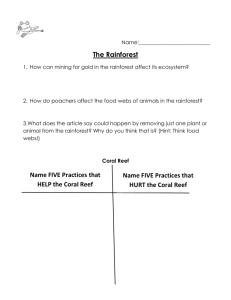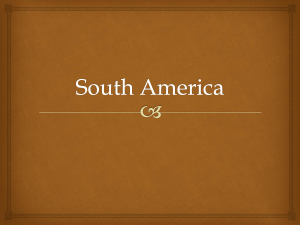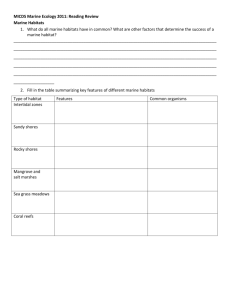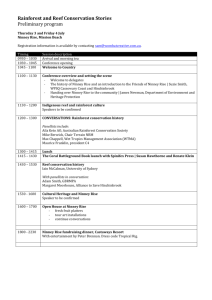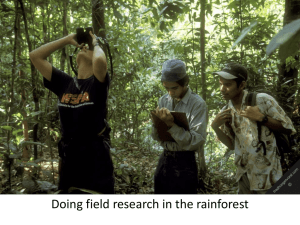7401-20130918213754
advertisement
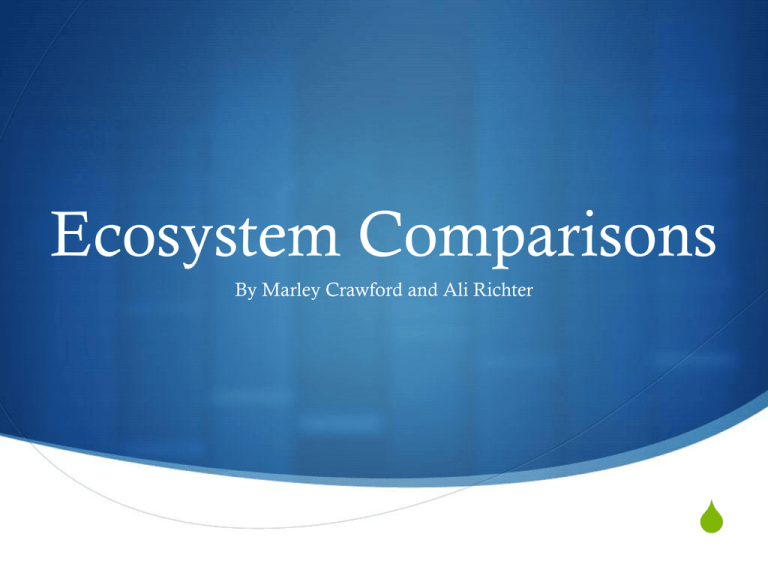
Ecosystem Comparisons By Marley Crawford and Ali Richter S Abiotic and Biotic Factors Rainforest: Reef: S Biotic- trees, vines, flowers, monkeys, bugs, tigers, birds, etc. S Biotic-fish, seaweed, sharks, bacteria, shrimp, squid, and crab S Abiotic-hot and wet year round, nutrient poor soil, high humidity S Abiotic-oxygen, sand, rocks, shells, temperature, sunlight Limiting Factors Rainforest Reef Some limiting factors in the rainforest Limiting factors in reefs include disease, ecosystem are water, food sources, and the availability of food and space. sunlight, and space. If there is an If populations of animals increase, abundance of these resources, the then there will be competition for these carrying capacity may be exceeded. In resources. This will result in higher that case, the organisms would have to death rates of animals, and ultimately compete for the listed resources. smaller populations. Variations, Tolerances and Adaptations Rainforest Tropical rain forests are very dense, so leaves have adapted to try to capture as much light as possible. An example of this adaptation would be the leaves in the dark understory of the rain forest. They are large so they can absorb as much light as possible. Leaves that are in the canopy are smaller. The amount of water a plant catches is also controlled by leaf adaptations. Some leaves have drip tips and a waxy surface to allow water to run off to reach the ground. This stops the growth of bacteria and fungi as well. These leaves are able to tolerate different temperatures. Flowers in the rainforest called anthuriums have long thin leaves. This adaptation helps excess water run off the flower. Anthuriums that grow in other places aren’t shaped quite like the ones in the rainforest. The anthuriums in other places are more prone to disease (which could easily lead to this flowers extinction), but the anthurium population in the rainforest has generally stayed the same. The red eyed tree frogs spend most of their lives up in trees and are unable to hatch tadpoles in water. Their tadpoles grow in water pockets in the bases of leaves on plants (such as bromeliads). They have also adapted so that the blue marks on their backs are hidden when they sleep so that they are camoflauged and therefore safe from danger. The males are usually smaller than the females. They are able to tolerate living up in trees instead of near ponds. Variations, Tolerances and Adaptations Reef Corals in reefs, even coral of the same species, often vary in shape. In the picture it shows Montastrea annularis, while one side is platy in appearance, the other side is more mound shaped. The difference in appearance is due to the place (deep water /shallow water) the coral has grown inside the reef. They are able to tolerate small variations in temperature. Many fish, such as the clownfish, have adapted a certain shape and color to live in the coral reef. Colors vary greatly throughout the different species of fish, but most of them are bright colors. Clownfish tolerate living in reefs by taking shelter in anemones. This can protect them from predators. Algae is very tolerant of dampness and light, so it has adapted to living in reefs by living in the shallower depths of coral reefs. Algae can vary in texture and color. Red algae is common in coral reefs. Symbiotic Relationships (Rainforest) Symbiotic relationships exist in all ecosystems because they help organisms survive. S The relationship between capuchin monkeys and flowering trees is a mutual relationship, because both organisms benefit. When the monkeys feed on the nectar in the flower, pollen gets on their faces. When they eat from other flowers it pollinates them, helping the flowers. The monkeys benefit by having the flower as a food source. S The relationship between Ecitoninae (New World army ants) inhabiting the rainforest floor and antbirds (small dull-colored South American bird species) is an example of commensalism. The army ants eat the things in their path, and the ant birds follow them and eat their leftovers. The ant birds benefit, while the ants themselves are unaffected. S The relationship between ticks and monkeys is an example of parasitism. The tick lives on the monkey’s body and sucks its blood. This benefits the tick and harms the monkey. Symbiotic Relationships (Reef) Symbiotic relationships are vital to ecosystems ability to survive. S The relationship between coral polyps and zooxanthellae is an example of mutualism. The zooxanthellae performs photosynthesis, and provides oxygen and nutrients to the polyps. The coral polyps provides carbon dioxide to the zooxanthellae so that it may undergo photosynthesis. S Since sponges are stationary they are easy to inhabit. They provide shelter for fish shrimp, crabs and other small animals. This relationship is an example of commensalism. S White tipped reef sharks are predators in the reef. They prey on sleeping fish and sea squirt. This is a predatorprey relationship. S The Goby and sea-urchins also exhibits commensalism. The Goby lives among spines of sea urchins, gaining protection. The urchin is not harmed or helped. Bibliography S http://www.com.univ-mrs.fr/IRD/atollpol/ecorecat/ukalgrec.htm S http://marinebio.org/oceans/structures-adaptations.asp S http://tolweb.org/treehouses/?treehouse_id=4841 S http://www.ehow.com/list_7495247_symbiotic-relationships-coral-reefs.html S http://life.bio.sunysb.edu/marinebio/coralreef.html
